|
|
 |
|
Not a lot of people know what is like being deaf and how to communicate
with them. In this page, I will show you my life experiences being deaf and how I overcome many obstacles.
I was born severely deaf. Another denifition is being profoundly deaf but profoundly means more deafness than
severely. There was no reasons for me being born deaf. It might be genetics but there is no history of deafness
on both side of family. I could go on and find some answers but there is no point as I am deaf already and there is
no cure for it.
-------------------------------------------------------------------------------
Story as far
Since May
2003, I had a sudden hearing loss. This now makes me a profoundly deaf person. I am having difficultly using my hearing
aid very well and have to rely on lip-reading completely. Since then, I am attending a Self-Management course and also
am seriously considering a cochlear implant.
I finally had my first appointment in Leicester, which was
on 15th October 2003 to see a consultant (Mr RSA Thomas). He has referred me to Nottingham Implant Program. Most importantly,
he said that with all the details he know about me, I will have a good success with having a cochlear implant.
13th January 2004
I had my first appointment in The Ropewalk Hearing Centre in Nottingham on 13th January 2004
with Tracy ONeill. It was a same old routine as she started asking me questions about my hearing and then we had a hearing
test to see my hearing level. We also did a speech test, which I havent done before. The speech test is when I wear
a headphone and I had to repeat what was being said. I have to say it was quite hard and I dont think I did very well.
Anyway, she managed to answer all the questions I asked her and her answers are shown bottom of this page.
10th March 2004
(Written before the appointment)
This appointment will be for a new hearing aid fitting. I feel this appointment is useless
because they are giving me a powerful hearing aid. I want to tell them that no matter how powerful is the hearing aid
is, I still wont able to hear more clearly. Also, it will make my tinnitus much worse. However, my mates namely
Catherine Wells, Laura McAuley and Daniel Rule assured me that it does make a difference so I will keep my comments to myself.
(Written after the appointment)
On 10th March 2004, I went for my 2nd appointment in Nottingham to get a new hearing aid.
I meet Karen Goodrum-Clarke who is a Principal Audiologist.
Anyway, She gave me new DIGITAL hearing aids. I have to say that they have
improved my hearing a bit since I had a hearing loss. Remember, I said before that I get tinnitus (ringing noise inside
the ear which can make me go dizzy), which is triggered by constant loud noise? Well now with the digital hearing aid,
they have a program, which allow shutting out unwanted loud noise!! This means that I have less chance of getting a
tinnitus now. However, it doesnt mean that I can hear like before I lost my hearing.... it is just an improvement.
13th April 2004
For this appointment, I went to see Dyan McKinley, who is a Specialist Speech & Language
Therapist. I was expecting to meet a man but this person was a lovely american lady. She was assessing
my speech and communication abilities and gave me an opportunity to talk about cochlear implant.
First we talked about the history of my deafness....again!! I didn't mind as it is fair for Dyan to know
everything about me. Then she started asking load of questions about my communication skills. some questions was like
"How would get a person attention if you want to speak to him/her?", "Would you able to respond if someone is calling me?",
"Can you use a telephone?" and many more!! I can't remember all the questions but I remember embarassing my Dad as I
told her that his "attitude" when he speaks to me is very disappointing. He sometimes speak too loud, talking behind
his back and gave up speaking to me when I didn't understand him. He he...this is true...even Dad agreed with me during
the appointment!!
Then we did a picture book. This is somthing I did before. I have to name what is a picture of. After
each picture, she would write down how I pronounced it.
Then we did the exciting bit. She did a video of me reading a passage and reading a script of conversation between
two people. Reading this script was hard because I has to control the tone of my voice. This was done
because she wanted to see the comparison of my communication skills now and 1 year after the cochlear implant is switched
on.
At the end of our appointment, I asked her about how many apppointments do I have to attend at the moment. She gave me a
surprising response. She told that there is about 4 or 6 more appointments left including the MRI scan.
I was expecting more but I was happy to hear this. I won't seeing Dyan again till 1 year after I get
a cochlear implant. However, I can arrange to meet her anytime for improving my speech as my pronunciation is not exactly
perfect you know!
19th April 2004
A day after my London marathon run, I went to see Mary McGee, a Chief Hearing Therapist for
a hearing therapy session and a possibly of doing a vestibular test! But we did NOT actually did the vestibular test
as she said it wasn't supposed to be mentioned in the letter yet. I still dont know properly on what kind of test it
is. Someone told me that it might be a kind of a balance test. I am glad I didnt do this test because my whole
body was aching from the marathon run. Anyway, this appointment was for Mary to be sure that I have access to any special
equipments such as, doorbell and telephone flashing light, minicom, subtitles on tv, etc. At the end of the session,
it was decided that I should get a smoke alarm alert and a new vibrating alarm clock.
This appointment and previous ones has no bearing on any assessments for cochlear implant. Mary told me that
from my next appointment, they will assess me "properly" for cochlear implant. I was pleased to hear that. Now
I can't wait for my next appointment!
10th May 2004
I went to see Tracy O'Neill again for another Pre-Implant Assessment but it was a first proper assessment. After my
weekend of adventure near Northampton, again I turned up this appointment really tired and a bit bruised.
This session took over 2 hours and a half.
First we did the normal hearing test. This is pressing a button when I could hear a sound / noise. This was
done in four stages. One was without hearing aids, then only one left hearing aid switched on, then only
one right hearing aid switched on and then both hearing aids switched on. Tracy told me that my
overall hearing particularly with digital hearing aids has made my hearing improved. I agreed with her as
it made a significant improvement but I don't think it improved enough to get what I want.
After the hearing test, we went straight to test my middle ear. This is just to test my eardrum. On each ear
at one time, she put an earpiece inside. This earpiece would create a pressure that will move my eardrum. There
were some readings on graphic computer that prove that my eardrum actually moves. This is great news I think.
The next assessment was to test my lip-reading skills!! This is something I thought it would be easy but from
this appointment I found it hard. There was this man talking on a television and I had to repeat what was he was saying.
Again, I did this test in four stages as described in above second paragraph. I thought I did well as
I pick out words and make them into a sentence. There was sometimes that I didn't understand what that man was saying.
I told Tracy that I had to know what is a topic/subject of this man was talking about first then I would more likely
to know what he was saying.
The next bit I did was a computer test and a questionnaire. The questionnaire was a personal one
as they asked me about what I think about my lifestyle and want to know my feelings and thoughts. The computer
test I did was more like an IQ test. There was a random letter coming up on the screen each time and all I had
to do is press a spacebar immediately after I see a
three-letters word. It took about 2-3 minutes and I do not know if I got them all correctly but Tracy told me I
did well.
The last test was a curious one. It is called an Otoacoustic Emission test. It was just a earpiece, on each
ear at one time, which was connected to a small box. I asked Tracy to explain what is this test for.
She happily wrote this down on a piece of paper. "It puts quiet clicks into the ear, and looks to see if the ear
sends a sound back out. If it does, the ear is working - but there may be a hearing loss if the nerve or brain
doesn't deal with the sound properly. No emission means there is a hearing loss - mild or worse." As expected,
there was no emission recorded from my test so it was proven that I do have a hearing loss!
That was an end of our appointment although we did a bit of questions and answering session but nothing new for
you to know about. He he.
27th May 2004
I had a hearing test in the Evoked Potentials Clinic of the Medical Physics Department in Queen
Medical Centre. My ENT recommended that I should undergo evoked response audiometry to assess my hearing loss.
The test procedure involves the technician placing two sticky discs (electrodes) on my head and one behind each ear (fours
of them altogether). Once this was done, I had to wear a headphone. The tests involve playing sounds through headphones and
I would just try to listen.
In the first part of the test, I had to to sit still and relax. It was important that I had to stay alert
and keep my eyes open meaning I can't fall asleep at all. This test took about 20-30 minutes.
In the second part of the test, i had to lie on a bed again with the headphone. Same rules apply except I can go to sleep
or close my eyes. This took about about one hour.
The evoked potentials are generally recorded from the electrodes. A special-purpose computer is used to record the response
from these electrodes. Typically, it will need to gather information for two or three minutes for each response.
The number of responses depends upon the particular investigations
During the tests, it was friggin' hard to stay still. I hestitated to move most of the time and this does not made
me relaxed for sure. It might be easy for others to stay still and relax but not for me!!
I met Dr. Steve Mason after my test to give me a chance to ask questions. He said that the result of the tests is
what he expected meaning that I have a hearing loss... didn't I knew that!! Anyway, these investigations are just a
part of the overall assessment for cochlear implant so mainly it assesses certain aspects of my hearing, how well my ear recieves
the sounds and how sensory nerves carry information to my brain.
8th June 2004
A much-waited MRI scan appointment at Queen Medical Centre (QMC), Nottingham. I did
wait even more though. I arrived on time for my 3pm appointment and I waited for 45 minutes!!
It was simple quick progress. Once I was called, I was told to fill in a questionnaire just
for basic information about my medical history. I had to remove all the metal objects such my watch, hearing aids, necklace
etc.
I had to lie down on a bed that will pull me me the big circular scanning machine. I was told
that it would take 20 minutes but it felt like half a hour. Despite a strong brace around my head to stop
me moving, I had to move a little.....I thought I spoiled the test...arghh. I had to move really cos I was thirsty
(bleeding hot day it was!!) and my salvia was building up in my mouth and I have to gulp it in!! Also during the
test, I could either felt or hear the vibration pulse as it came regularly each time. Maybe it was scanning at the time.
After the test, I got up and I did feel a bit dizzy. It is just the same as me getting
up in the morning or perhaps it was caused by the vibration pulses I been getting in the scan. Anyway, I felt fine
few minutes later. I told by a supervisor that I will get the results from Nottingham Ropewalk soon.
So basically, I was kicked in the butt to go home!! (just a joke)
23rd June 2004
Met Mary McGee again but for the first pre-conselling session. Originally this appointment was supposed to
be scheduled before me having a Evoked Potential test and MRI scan so she would explain these tests to me. But having done
these tests, we talked more about the cochlear implant devices and the operation. I was well pleased!!
Before the conselling, I had to answer 20 questions on a computer about what do I expect after having an implant. I cannot
remember the questions clearly but I would expect the hearing quality from an implant would be the same or better before
I had a hearing loss with my hearing aid.
At the start of the conselling, Mary talked about the possible risks and side-effects from the operation.
- Meningtis - occurence of infection following cochlear implantation. I will need a Pneumoccocal vaccination between
my final consultation with my ENT consultant and the sugery. It is very rare to get this or any kind of infection.
Meningtis only happpened overseas...never in UK.
- Loss of balance - after the operation, there will be an initial sense of loss of balance but it is very rare
this balance loss will be pernament.
- If the nerves were damaged during the operation, the side of face near the implantation could be stiff, numb or even paralysed.
AGAIN, this is very rare as operation nowdays is very precise.
- Disturbance of taste- may taste metallic taste after the operation
Mary then showed me the possible two different implant system that I will have to choose. I nearly panicked because I had no idea how I am going to choose. Anyway each implant devices are HiRes Auria and Nucleus 3 System.
Below I have made a summary for these two devices. They are made by two
different companies so theirs features are different.
HiRes Auria
-
Have ear hook options:
-
T-Mic which
uses T-loop system that used in cinema, railways station, mobile phone and etc
-
Direct Connect
which allow plug-in for devices such as MP3 and CD players

|
| HiRes Auria |
Nucleus 3 System
- Use three hearing aid batteries size normally lasted over 3 days
- Whisper Setting- a program, which can boost soft sounds
- Have T-loop option
- Use 24 electrodes
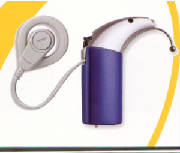
|
| Nucleus "3" System |
After thinking and reading
the booklets provided, I am more likely to choose the HiRes Auria system. Here are the reasons why:
- Nulceus "3" system may pick up more different
sounds than the HiRes system because of the number of electrodes. I have to think which is best for me. In noisy
environment, Nucleus "3" system could be a disadvantage as it might trigger my tinnitus, although there will be a program
to stop me from getting it.
- I like the fact that HiRes have Direct Connect because it
will give me chance to listen music easily and on my own.
- I would rather use rechargable batteries than
using the hearing aid batteries because for hearing aid battery, I would have to travel more often to
local hospital to get more batteries.
Lastly, she asked me
if I want to meet someone who had an implant and learn about his/her experiences. I know many people especially my friends
who had an implant and I already know what to expect and will still pestering them with my questions. However, I would
to meet someone who is actively in sports and Mary will see if she can find someone in that criteria.
21st July
2004
2nd Pre-counselling session with Mary McGee. More questions for me to ask and
Mary to make sure that I fully understand what I expect from having an implant.
From the implant, I would expect to hear different types of traffic and the tone of people's
voice. On telephone issue, not all people with implant will use telephone comfortably as conversation may be limited to one
or two sentences. I could listen to music well as before and will continue to like new music.
I asked several questions here is a few of them answered:
-
A surgeon do not have any preference on implant system in term of which one is easy to operate with.
-
There will be no splitting up nerves between ear and facial. For operation, they will have tools
to protect these nerves.
-
In HiRes Auria implant system, the DirectConnect is not wireless for to listen to music.
-
To get actively in sports or going to atlon towers etc, it is safe to do so 2 months after the operation.
-
It is up to me how long I should take time off work for the operation. Normally two weeks is
enough time to recover but some people waited till they get their implant switched on (up to 4-6 weeks).
-
There have been 3 failures in the last 14 years in QMC. One had a infection. Two of them
had fault in their HiRes Auria system after using it for 5 and 10 years. However, they had it replaced and returned back to
their normal life.
-
QMC have no reports over the superbug MRSA.
We also talked about my balance and dizziness and she told me that I shouldn't have any problem.
I will ask more about it to my ENT consultant.
Mary has said that I have much advantage over many people who is waiting for an implant because I
seem to ask so many questions and seem to have a best knowledge about the implant due to me having friends who had an implant.
To me, I am lucky enough to have these friends.
Now I will have to wait
for an appointment letter from Mr Gibbins, an ENT consultant. He would tell me whether I am suitable for an implant or
not! If yes, I will barge him with loadsa of questions, even the silly ones. I was told by Mary that I can ask
him any kind of questions.....he he.
23rd March 2005
Finally after 8 MONTHS and 2 days since my last appointment..... I met an ENT consultant Mr Kevin Gibbins
at Queen Medical Centre. This appointment is to discuss the results of the scan and to find out whether I
can have the cochlear implant operation or not.
SOOO.......as soon I entered
his clinic, he started talking about the risks of the operation. At this time, I still do not know whether if I am having
the operation. As I am already aware of the risks and he made sure that I do. He then asked me if I have any questions
to ask him. I then smiled and took out 3 pieces of A4 paper of questions.
My first obvious question
was to ask him if I am suitable for the operation.....and much to my delight, he answered "WHY DID YOU THINK I BROUGHT
YOU HERE??"
Then I began to ask him more
questions which was very satisfying and it make my decision stronger to go ahead with the operation. Some answers are shown
below:
- They will operate on my
good ear which is my right side and having a history of tinnitus does not affect the performance of the implant
system.
- Having this operation does
not influence my ability in athletics and other sports and have to avoid body contact sports.
- My balance will be affected
for 2 days after the operation and it will return back to normal.
- There is a rare risk of
having a facial nerve damaged as this surgeon have no history of failure due to being careful and experience.
- there is no MRSA superbug
in their ward. This is a killer bug been killing patient in UK hospital more recently. I was quite worried about
it anyway
- I got to have a vaccination
for meningitis…..just in case.
- There can be failures in
operation and times after the operation. But it doesn’t mean it will be a complete failure completely as there
will a re-implantation to ensure it will work.
- I wont need medical insurance
as my dad keep telling me……stop bugging me about this dad!!!
- I will spend one night
in the hospital and will need 3 weeks off work. Then 6 weeks after the operation, they will turn on my implant system and
I will have to LEARN to listen like a little baby normally do......not much too work I hope.
Confirmation from letter:
Date of operation: Monday 2nd May (yes...it
is MAY DAY BANK HOLIDAY)
Time:12:00 pm
Consultant: Mr KP Gibbins
Ward:EC24 (Ward C24, C Floor, East Block)
I found the date of the operation when I opened the letter on 1st April 2005. It was
a bit of a shock when I read this letter. I opened the letter in the empty house and I started shouting
all sort of things. Dont get me wrong, I am really happy to get this implant after nearly two years of frustration but
it would mean I have to make few sacrifices like my running and my new job. I had to tell my manager on Monday about
this news as I will be offically pernament at HSBC on 18th April although i havent signed the contract yet I will
be telling them I want to have 3 weeks off from 2nd May. As of now, they are aware of it and they are pleased that I
am having this operation. For my running, I have to drop out training meetings with the Deaf GB team for
European and World Championship events this year but I should expected it anyway.
There is one or two funny stories about when I was texting SMS to my friends and family.
Some of them thought it was a April Fool's joke as it was on the 1st of April. I had to re-assure them that it is not
a joke! My actual text message read out "News Flash: Hitz got a letter frm da hospital. He will be havin da cochlear
implant on 2nd May 2k5. At da mo, Hitz is recoverin frm shock as he also fainted. Tis is Lois Lane, BBC News".
One of the best replies to me was from Edwina (Edward Rex).....he replied with this text message "News Flash: superted
has rescued hitz from his sudden faint off a building by the words of congrats. Unforfortuantely the world will end on 2nd
of May 2k5 as the dark side of hitz is unleashed with newfound hearing powers. This is Lois Lane naked reporting 4 BBC
News".
What Next???
Click on a new page "COCHLEAR IMPLANT" to read about the operation and more stories n picz!
------------------------------------------------------------------------------
|
 |
|
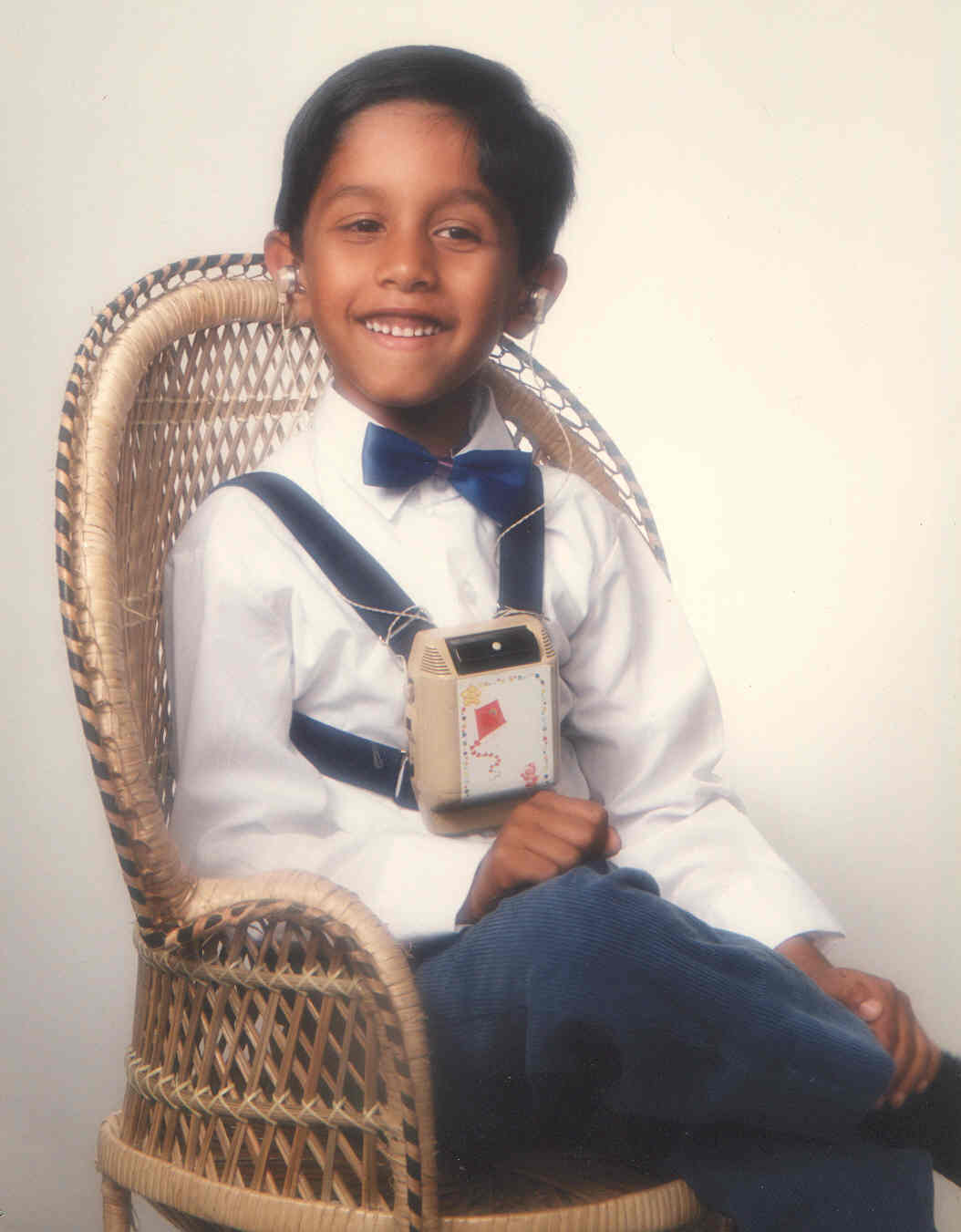
When I was little, the modern technology of hearing aid was not that advanced. In this picture (right),
I wore a big radio system strapped on front of my chest. It is not a hearing aid on its own cos there was a mircophone
linked this device. I do not remember complaining about having this on my body as it seem heavy and look quite ugly.
Maybe I was just happy to wear this because it helps me to hear for a first time.
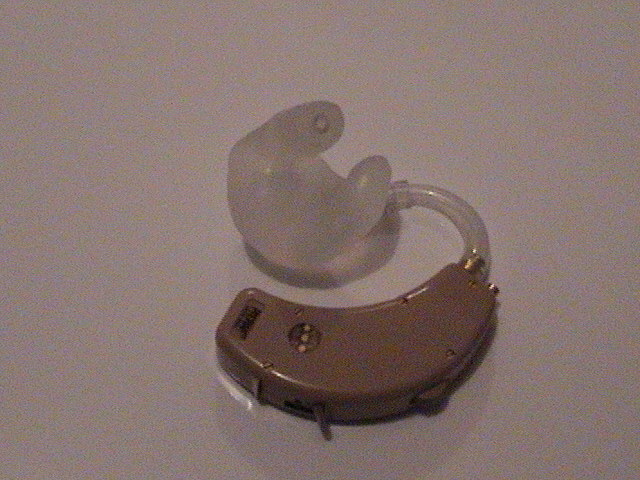
Before I started mainstream school, I was wearing a Phonak hearing aid, which is small and almost featherweight.
This is much better compared to the one I had strapped on my chest. The hearing aid (pictured left), is designed to
hang over an ear and its small size is helped by integrated circuits inside. I was so happy to wear this because it
enables me to take part in sports such as football, cricket and rounders in early days.
Radio System
This is a device which mainly help deaf students like me to listen to lecturers and also is quite useful for
attending meetings.
It work as exactly a radio where a microphone is a transmitter , and input shoe is a receiver. Its channel
frequencies is very unique and is under the European standard because it might interfere with other radio devices.
It enables me to listen to one voice very clear and sharp, no matter how far is that person is. The input shoe
can allow to switch off the background noise and only let me hear what is being said on the microphone. These pictures
below shows the microphone and a receiver and how it is being attached to my hearing aid.

|
| Microphone |
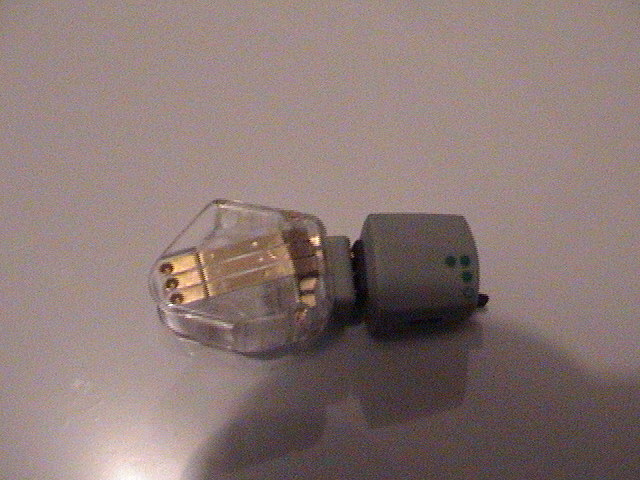
|
| Receiver or Input Shoe |

|
| Receiver and Aid attached |
.
Minicom
Minicom is also called as TypeTalk. It is a telephone device for hard of hearing people who can't actually use
the phone properly. It does not use voice conversation as it uses text conversation. To describe this operation much
clearer, it is like using text messages (or SMS) on the mobile phone but operate in real time as there is no delays in replying.
Like mobile phone, there must be a minicom on both side of communication. However, this does not stop hearing
people to use voice to conversate with someone on a minicom. There is a RNID service that enable us to do
that.

RNID TypeTalk is the only national telephone relay service which enables deaf, deafblind, deafened, hard of hearing and
speech-impaired people to communicate with hearing people anywhere in the world. Keeping in touch with friends and family,
fixing appointments, ordering pizzas, talking with the bank - in fact, everything hearing people take for granted is available
through RNID Typetalk.
RNID Typetalk provides a link between the textphone user and the hearing person. The link is a highly trained RNID Typetalk
Operator who understands the needs of deaf and speech-impaired people and provides a discreet and confidential service.
Textphone users dial direct using the 18001 prefix before the number of the person they would like to speak to and RNID
Typetalk Operator joins the line to relay the conversation. The textphone user will then type their part of the conversation.
A RNID Typetalk Operator will read exactly what is typed to the hearing person. The hearing person replies and the RNID Typetalk
Operator will type exactly what is said so the textphone user can read the response on their textphone display panel.
My Communication
I think I was lucky enough to start my education in mainstream school. This has helped me to speak orally very
well. Spoken English may be modified in a number of simple ways to make it more lip readable for a deaf people using English.
The ways include clearer lip movements and more use of gestures and facial expression to help convey meaning.
Hearing impairment like me leads to much frustration in communication but many other communication problems
are often caused by the thoughtlessness and poor practices of those speaking to hearing impaired people. The following points
can be useful when speaking to those with a hearing loss.
Be Visible
- Get the person's attention before speaking.
- Keep a good light on your face, this makes it easier to lip-read.
- Stay at a comfortable distance.
- Keep your head up and don't turn away.
- Don't obscure your mouth by fingers, cigarettes, etc.
Be Clear
Speak clearly, perhaps a little louder than usual but DO NOT SHOUT. Shouting distorts the lips, makes it difficult to
lip-read, and makes it embarrassing for both of you Speak with the ordinary rhythm and flow of speech As far as possible,
cut out background noise
Be Concise
- Come to the point and don't waffle.
- Make sure that the listener understands the subject at the beginning of the conversation.
- It is a good idea to write it down.
- Don't change the subject without warning.
Other form of communication is by using sign language. I am a mild user of sign language because most of my deaf friends
don't use sign language as they mostly lip-read. I am gradually learning more BSL (British Sign Language) and I find
it more easy to communicate with BSL. If the whole world have a universal language, I hope it will be BSL. Although
it be may be disadvantage for people who can't use their hand!
Sign Language
Sign Language is a form of communication using hands. It is easy to conservate with this especially for people who
cannot speak orally. The basic finger-spelling of alphabet is shown before and see if you can spell your name using
sign-language.

Cochlear Implant
This is a new section I am putting on this page because I am seriously considering having a cochlear implant (Bionic
Ear). As you know I had a sudden hearing loss and I am finding it hard to cope when talking to people especially
to one whom I never met.
Some people said that I was deaf already and is confused what was the fuss is about. Well before I was severely
deaf, I could listen very well with my hearing aid. It was good enough to able for me to communicate the phone
with someone I know and also I could able to recognise a song or music. Right now, I just hear one type of sound
whether it doorbell or someone laughing. Sometimes, I developed a "ringing" noise whenever I switched my hearing aid
on and this will cut out the background sound completely.
What is Cochlear Implant?
"A cochlear implant is an electronic device designed to provide sound information for adults and children who have a
sensorineural hearing loss (nerve deafness) in both ears and obtain limited benefit from appropriate binaural hearing aids."
As I said before that my current hearing aid does not help me to hear properly. It doesnt really
matter how powerful and effective the hearing aid because it doesn't work like that. A cochlear implant is designed
to produce useful hearing sensations by electrically stimulating nerves inside the inner ear (cochlea).
What does the cochlear implant look like?
The system consists of internal and external components. The model shown in the Figures below is the NucleusŪ 24 cochlear
implant system.
The implant package (or receiver-stimulator) contains the electronic circuits that control the flow of electrical pulses
into the ear. It also contains an antenna that receives the radio-frequency signal from the external coil and a magnet that
holds the external coil in place. Attached to the package are wire leads that join to electrodes. The 22-electrode array is
inserted into the shell-like structure in the inner ear known as the cochlea. The ball electrode is placed under a muscle
near the ear. There is also a plate electrode on the outside of the receiver-stimulator package. All of the parts shown in
Figure 1. are placed under the patient's skin behind the ear during the implant operation.
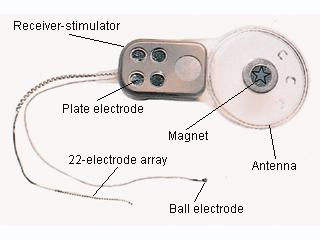
|
| Figure 1. The internal component of the cochlear implant |
The other parts of the implant system are worn externally. The coil is held in position against the skin by a magnet
and the microphone is worn behind the ear. The body-worn speech processor (SPrintTM) can be worn in a pocket, in a belt pouch
or in a harness. The ear-level processor (ESPritTM) is worn behind the ear. These parts, which are shown in Figure 2. are
normally fitted four weeks after the operation.
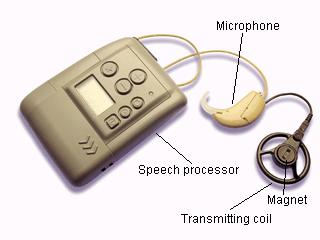
|
| Figure 2a. SPrintTM speech processor |
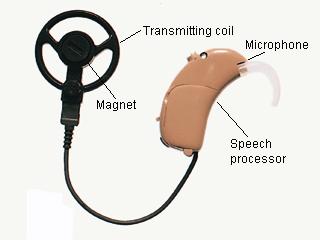
|
| Figure 2b. ESPritTM speech processor |
How Does Cochlear Implant Work?
Speech and other sounds are picked up by the microphone and sent to the speech processor. The processor codes the sounds
into an electrical signal which is sent via a cable to the transmitting coil. The coil passes the signal through the skin
to the implant which transforms the signal to electrical pulses. The pulses pass from the electrode array and stimulate hearing
nerve fibres within the cochlea.
The speech processor does not just make sounds louder as does a hearing aid. Instead, it selects out some of the important
information in the speech signal and then produces a pattern of electrical pulses in the patient's ear. This pattern is selected
to sound as close as possible to the original speech sound. It is not possible to make sounds completely natural, because
there are only 22 electrodes that are replacing the function of tens of thousands of hair cells in a normally hearing ear.
The electrical patterns are different for each person and need to be programmed into the speech processor by a trained
clinician. The differences arise because the electrodes are not always in the same position relative to the surviving nerves
and the nerves vary in sensitivity to electrical currents. The clinician must measure the lowest and greatest current for
every electrode to determine the softest and loudest sounds that will be heard. The different electrodes produce sounds with
different pitch. The speech processor combines sounds on different electrodes with different loudness, to build up something
as close to the original sound as possible.
The hearing process using a cochlear implant can be summarized as follows (please refer to Figure 3):
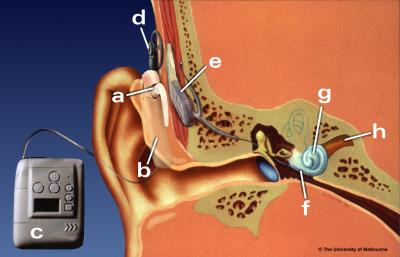
|
| Figure 3. The hearing process using a cochlear implant |
a. Sounds and speech are detected by the microphone.
b. The information from the microphone is sent to the speech processor.
c. The speech processor analyses the information and converts it into an electrical code.
d. The coded signal travels via a cable to the transmitting coil in the headset. Radio waves
from the transmitter coil carry the coded signal through the skin to the implant inside.
e. The implant package decodes the signal. The signal contains information that determines how
much electrical current will be sent to the different electrodes.
f. The appropriate amount of electrical current passes down the appropriate lead wires to the
chosen electrodes.
g. The position of the stimulating electrodes within the cochlea will determine the frequency
or pitch of the sounds. The amount of electrical current will determine the loudness of the sounds.
h. Once the nerve endings in the cochlea are stimulated, the message is sent up to the brain
along the hearing nerve. The brain can then try to interpret the stimulation as a meaningful sound.
What is involved in the pre-operative assessment for the cochlear implantation ?
A doctor or an audiologist conducts a careful evaluation to determine if I am an appropriate
Cochlear Implant candidate. Audiological tests establish my level of hearing loss. Hearing aids and other devices are
fitted to establish whether or not these devices might be beneficial. I will be counselled regarding the potential
benefits and limitations of the Cochlear Implant. If the audiological tests indicate that the person might be a candidate,
medical tests are performed. X-rays are taken to see if the cochlea is suitable for an implant. A promontory test may also
be performed to determine if electrical stimulation of the auditory nerve (hearing nerve) will result in sound.
The implant team will terminate the evaluation process if either they or I determine that I am not an appropriate
candidate.
Summary of above:
- A trial with the most up-to-date and power hearing aids.
- Audiological tests - to show if I still have any useful hearing.
- CT (computerised tomography) or MRI (Magnetic Resonance Imaging) scan to look at my inner ear and see whether there is
anything that might affect me having a cochlear implant fitted. Both of these scans are painless.
- Balance tests.
- Electrical tests - to see if my hearing nerve can respond to electrical signals and to show whether an implant has a chance
of working.
- Psychological tests.
What are the risks of Cochlear Implant surgery ?
The primary risks of Cochlear Implant surgery are the same basic risks associated with any type of surgery that requires
general anaesthesia. There are also a few specific risks related to operating on this section of the head. These risks include
inflammation, infection, disturbance to the facial nerve, stiffness or numbness around the ear, disturbance of taste or balance,
and noticeable change in tinnitus (head noise).
Although it is important to be aware of the possibility of these complications, the fact is that there have been few
significant negative side effects from the surgery in the individuals who have received the Nucleus Cochlear Implant.
What happens after the operation?
The implant will be "switched on" a few weeks after the operation. The first noises I may notice are sounds such
as footsteps, running water and birds singing. These are kind of noises that I wouldn't able to hear with my hearing
aids.
It takes time and practice before people become comfortable using the device, and thinking of the sounds they hear as
their 'normal' sounds. The clinicians try to speed the process up by providing listening tasks at each session. These tasks
involve listening to words, sentences and conversations, and practising using different strategies to improve communication
situations.
THE QUESTIONS I ASKED TO MY SPECIALIST AND
HER ANSWERS
- I have a ringing noise on my right ear. It occurs when my right side hearing aid is
switched on. Normally the noise is triggered by loud background noise. Could this stop me getting an implant?
The answer is simple no. This is called tinnnitus. Most people
say that this tinnitus will get better with cochlear implant. Some do not.
- Will I be getting a latest model for cochlear implant?
Yes. Right now, there will be two choices of cochlear system.
- Is there is any chance the implant will be "faulty" after having it for years?
If yes, what would happen next?
If it get faulty, there will be re-implantation.
- Do electric shock from cars, doors etc can damage the implant?
It cannot damage the implant severely but the implant system may need re-programming.
- I am quite an active person. I played football, cricket, tennis, athletics and cycling.
Does having an implant affect my balance and my ability?
No, at not all. There will be tests to see if it does affect your balance.
- Could any of the sports listed is dangerous while having an implant?
Well, the contact sports such as boxing and rugby are dangerous. Use common sense!!
Swimming is fine. Helmet-worn sports are fine as well.
- While having an implant, is it vital to have a medical insurance?
Not really. If the cochlear system need replacing, it will be free. Most people
do take medical insurance in case of damaging other nerves in the body during the operation or in general.
- How long approximately these assessments will go on to find out whether I am suitable for
the implant?
Its all depends on how often we see you. It could be up to 12 months as we will keep
seeing you once a month.
- To relation to above question, I understand that I will have to go on separate appointment
for assessment, could you tell me how an appointment is arranged?
We will send you a letter and you will have to confirm the appointment.
- This just happened recently and only once and I wasn't going to tell you but my friends who
had cochlear implant told me that I should mention it to you.
I went to McDonalds. It was quite noise inside and I forgot to switch
off my hearing aid as I was trying to order a food. As expected, the ringing noise in my right ear was triggered. But
this time it seems so strong. I took no notice of it. Few minutes later, I realised that I was late for something and
I decided to eat my meal very fast. Then I started get dizzy. It was so strong as I never had it before.
An hour later, I started vomiting and again later on.It took me at least three
days to recover from this as I felt a bit down. I was scared that it might come back again. But now, I am healthy
and fit. This was probably due to me eating so fast but I never get so dizzy when my ear start ringing. My question to you is whether you can tell me if this is any way connected to my hearing and whether it can
affect my chance of having an implant??
There is a term called VERTIGO. This is common for people who had hugely profound hearing
loss. This can affect your balance and get dizziness. Again, this won't affect your chance of having an implant.
We will be doing series of test to see how good is your balance. As this only happened once, we cant tell you whether
you had vertigo.
- Do you have any idea why I had a hearing loss??
At once, I though it could be that I was using my MP3 player too much. It
was connected by FM signal so it could damage my ear. I heard on news that microwave signal like mobile phone can damage
your ears. So it could this reason or due to loud continuous noise to my ear.
There is no conclusive reasons to give.
Useful Links associated with Deaf
DELTA (Deaf Education thru Listening & Talking)
RNID (Royal National Institute for Deaf)
British Deaf Association
NDCS - National Deaf Children Society
Connevans - Equipment for Deaf and Hearing Impaired People
Phonak - Hearing Systems
|
 |
|
|
 |
|
|
 |
|
|
|
|
|
|
 |

